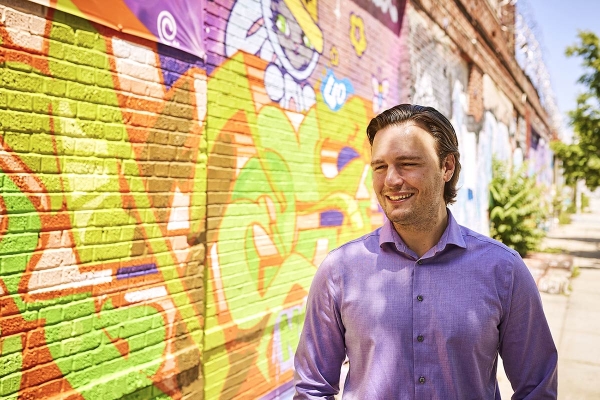How an Erstwhile English Teacher Is Optimizing Blockchain Technology
Like many millennials whose careers were repeatedly derailed by crises beyond their control, Frank Mathis spent the last two decades trying to catch a break.
A creative writing major in college, he spent his early adult years teaching English and aspiring to be “a great American novelist,” as he puts it. Then came the 2008 recession, which put Mathis, like many young strivers at the time, out of a job.
So he pivoted to banking, where he taught himself how to succeed in financial planning roles. But the industry’s inertia following the financial crash, combined with a series of setbacks in his personal life—“At one point I had lost everything I had.”—left him yearning for more. The onset of the pandemic in 2020 only piled on to a sense of aimlessness.
That point, however, is when Mathis finally found the momentum he had been seeking for years. Instead of giving in to frustration, he decided to invest his energies in something new, an endeavor he found both more exciting and more important than finance. He co-founded a company, GenesysGo, that aims to be “the onramp for everyone that wants exposure to the benefits of blockchain, but who needs to work from a legacy business infrastructure.”
Mathis has long had an interest in blockchain infrastructure, nodes and protocols, if not cryptocurrency (he calls himself the “opposite of a crypto nerd”). He’s also passionate about the decentralized networks and communities that blockchain technology enables.
Those interests led Mathis to begin experimenting a few years ago with Solana, a blockchain introduced in 2018 with the goal of achieving much more reliable and faster performance than other blockchains. Along with business partner Steven Easley, Mathis built a remote procedure call (RPC) node (a special type of device on a blockchain network that allows applications to interface with the network) and ran it in a small data center in their neighborhood.
They soon realized that the node was less reliable than it needed to be to deliver the level of performance Solana developers were chasing. And it wasn’t just them. They met dozens of Solana developers across the world who reported similar issues standing up reliable RPC nodes.
A New Vision for RPC Nodes
So, Mathis and Easley decided to build a company whose first mission would focus on delivering faster, more reliable RPC nodes for the Solana community.
Their strategy rested on two major innovations. First, they decided to offer hosted RPC nodes that run on bare-metal servers instead of public cloud virtual machines. By sharing each server’s resources with multiple Solana developers, GenesysGo is able to optimize server capacity utilization while maintaining high performance levels. This approach is much more efficient and much less costly, Mathis says, than the conventional strategy for building high-performing RPC nodes, which is to dedicate one server to each application–a model that leaves most servers underutilized and leads to high infrastructure costs for Solana developers.
Second, the GenesysGo founders launched a campaign wherein they worked closely with Solana developers to understand which problems they were experiencing in interfacing with RPC nodes and then helping them solve those problems at the code level. This was crucial, because Mathis and Easley discovered that in many cases, poor Solana application performance wasn’t rooted in lack of hardware capacity. It was in inefficient code that wasted CPU cycles or managed traffic inefficiently. “The ultimate way to increase performance on Solana was not more hardware,” Mathis says. “It was about improving code.”
Close engagement with developers helped GenesysGo take off quickly. Indeed, Mathis says that the company’s node offerings weren’t necessarily the very best early on, but “what mattered more was that we engaged with developers. We didn’t hide in a corner. Our desire to want to help” put them into a position where they could enable the Solana community to be what it had set out to be: a blockchain that is objectively faster and more reliable than anything else in existence.
Today Solana, Tomorrow the World
Improving Solana RPC infrastructure is only the first of an ambitious set of projects that Mathis and his team at GenesysGo plan to tackle.
Next up is the launch of a decentralized storage solution (due to be released in late spring 2022) that is purpose-built for Solana. While other decentralized storage services exist, none address the unique quirks of Solana or meet its high performance standards, Mathis says, so GenesysGo set out to build its own solution from the ground up.
After that, “we’ll jump into other blockchains,” Mathis says. After making investments in the Solana community, the company hopes to bring similar performance enhancements to other blockchains, too.
And ultimately, GenesysGo’s focus will be on bridging the gap separating blockchains from the world of legacy infrastructure. “We want to connect Nasdaq to blockchains,” he says, offering an example of the type of seamless interconnection between the blockchain world and the traditional business world that is his company’s longer-term goal.
If those plans sound overly ambitious, consider that GenesysGo was founded in May 2021, less than a year ago. In that time, Mathis, Easley, and their small team–who worked with Equinix’s Startup Program and solutions architecture team to build out their infrastructure with access to (in Mathis’s words) “incredibly seasoned engineers”–have left a deep imprint on the Solana ecosystem. There’s no reason to doubt the company’s continued momentum as it targets ever larger goals.
Published on
01 July 2022Interview by
Katie NorchiIn pictures



